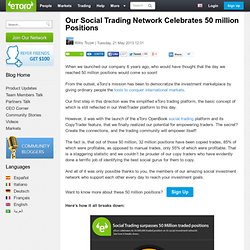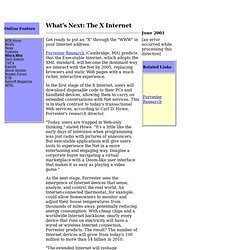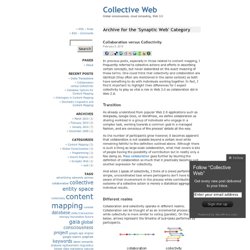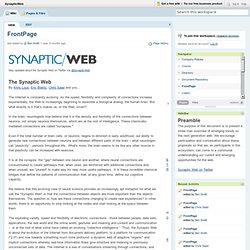

Buffalo - Products - Performance Matters. LinkStation Live™ is an easy to use 1-drive network storage device that comes equipped with a whole host of features, perfect for storing, sharing, serving and protecting your most important data.

Back up multiple PCs and Mac® computers simultaneously and enjoy uninterrupted access to terabytes of storage on your network and even over the Internet while away home. With terabytes of storage, LinkStation Live provides a reliable, central location to store all data from every PC and Mac® computer, tablet device and smartphone in your home or small office. Store, access and share files from anywhere on your home network! LinkStation Live is DLNA Certified™ and can be used as an iTunes® server to stream all of your favorite music, movies and shows to multiple playback devices simultaneously. Now you can relax and watch movies on your big screen TV while music is pumped outdoors by the pool. 4 Reasons Why Exponential Technologies Are Taking Off. Every so often, a novel technology emerges that propels society forward.

The 1974 release of the first personal computer, the subsequent birth of the Internet, and the development of cellular technology are all prime examples. Synaptic Web. Mashable. Our Social Trading Network Celebrates 50 million Positions. When we launched our company 6 years ago, who would have thought that the day we reached 50 million positions would come so soon!

From the outset, eToro’s mission has been to democratize the investment marketplace by giving ordinary people the tools to conquer international markets. Our first step in this direction was the simplified eToro trading platform, the basic concept of which is still reflected in our WebTrader platform to this day.
Forrester: Top Technology Trends for 2014 And Beyond. Terrafugia the World's first Flying Car. Terrafugia’s TF-X Transition Street-Legal Airplane, designed to be the flying car for all of us, able to takeoff vertically and reaching a speed up to 200 mph.

Flying Car Terrafugia TF-X™ is the practical realization of the dream of countless visions of the future and will focus the program with clear goals that enhance the safety, simplicity, and convenience of personal transportation. Inventors around the world have been trying to combine the ease and utility of driving with the three-dimensional freedom of flying since the beginning of the 20th century. The “flying car” has become a pop icon of the dream that never quite comes true. Until now. Predicting the Death of the Internet.
June Online Feature. Get ready to put an "X" through the "WWW" in your Internet address.

Is Google Places Search Permanently Closed? Google has removed the link to Places search.

The link, which had been located in Google's "More" drop-down menu option, is no longer there, meaning local businesses can only be found via search (paid or organic), Google+ Local, or Google Maps. Image via Understanding Google Maps & Local Search Also, when Google shows a 7-pack of local results, there is no longer an option to see "More results near [location]". Monsanto’s Dirty Dozen.
When you take a moment to reflect on the history of product development at Monsanto, what do you find?

Here are twelve products that Monsanto has brought to market. See if you can spot the pattern… Collective Web. In previous posts, especially in those related to content mapping, I frequently referred to collective actions and efforts in describing certain concepts, but never elaborated on the exact meaning of these terms.

One could think that collectivity and collaboration are identical (they often are mentioned in the same context) as both have something to do with individuals working together. In fact, I find it important to highlight their differences for I expect collectivity to play as vital a role in Web 3.0 as collaboration did in Web 2.0. Synaptic Web. SynapticWeb / FrontPage. Stay updated about the Synaptic Web on Twitter via @SynapticWeb The Synaptic Web By Khris Loux, Eric Blantz, Chris Saad and you...

The Internet is constantly evolving. Video Tour of the Jive Social Business Platform. Workplace Social Software. Analyst Report Learn, Collaborate, Connect, Close: Best-in-Class Mobile Sales Enablement For as long as sales and account management professionals have closed deals and supported customers, they have traveled to client locations, business events, and tradeshows.

The Banning of Google Glass Begins (And They Aren't Even Available Yet) Exploring the Consumer Media Universe. From televisions and smartphones to tablets and game consoles, Americans are consuming content on every device under the sun— the latest versions of which will be on display this week at the 2013 International Consumer Electronics Show in Las Vegas. According to Nielsen’s new U.S. Consumer Usage Report 2012, nearly 120 million people within television homes own four or more TV sets, and 16 percent of television homes own a tablet. Smartphone owners officially make up the majority of mobile subscribers, as 56 percent owned a smartphone as of Q3 2012. ‘Big Brother’ watching: creating a safer world; or goodbye privacy. Innovations: The Digital Revolution. As of July 1, 2013 ThinkQuest has been discontinued. We would like to thank everyone for being a part of the ThinkQuest global community:
Information and Communication Technology.